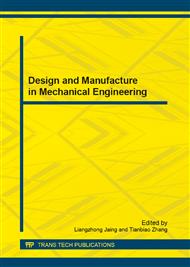[1]
Wada H., Metoki T., Kobayashi T., Analysis of dynamic behavior of human middle ear using a finite-dement method [J]. J. Acoust Soc Am, 1992, 92(6): 3157-3168.
DOI: 10.1121/1.404211
Google Scholar
[2]
Beer H.J., Bomitz M., Drescher J., et al., Finite element modelling of the human eardrum and application [A]. Proceedings of the Intenational Workshop on Middle Ear Mechanics, Dresden, Sept. 19-22, 1996 [C]. Dresden: University of Technology, 1997: 40-47.
Google Scholar
[3]
Gan R.Z., Feng B., Sun Q., Three-Dimensional Finite Element Modeling of Human Ear for Sound Transmission [J]. Annals of Biomedical Engineering, 2004, 32(6): 847-859.
DOI: 10.1023/b:abme.0000030260.22737.53
Google Scholar
[4]
Gan R.Z., Sun Q., Feng B., Wood M.W., Acoustic-structural coupled finite element analysis for sound transmission in human ear-Pressure distributions [J]. Medical Engineering & Phys-ics, 2006, 28: 395-404.
DOI: 10.1016/j.medengphy.2005.07.018
Google Scholar
[5]
Wenjuan Yao,Xin-Sheng Huang, Li-Jie Fu, Transmitting Vibration of Artificial Ossicle, International Journal of Nonlinear Sciences and Numerical Simulation,2008,9(2): 131-139.
Google Scholar
[6]
Wenjuan Yao, Bing Li, Cuiping Guo, Xinsheng Huang. Numerical simulation and study about partial ossicular replacement prostheses with several various materials on hearing restoration [J]. Application of Chemical Engineering. 2011, 238 (3): 2899-2904.
DOI: 10.4028/www.scientific.net/amr.236-238.2899
Google Scholar
[7]
Cheng T., Dai C., Gan R.Z., Viscoelastic Properties of Human Tympanic Membrane [J]. Annals of Biomedical Engineering, 2007, 35(2): 305-314.
DOI: 10.1007/s10439-006-9227-0
Google Scholar
[8]
Lu H., Luo H., Dai C., Gan R.Z., The young's modulus of human eardrum at high strain rates [A]. Society for Experimental Mechanics-11th International Congress and Exhibition on Experimental and Applied Mechanics, 2008, 2(1): 896-899.
Google Scholar
[9]
Cheng T., Gan R.Z., Mechanical properties of anterior malleolar ligament from experimental measurement and material modeling analysis [J]. Biomech Model Mechanobiol, 2008, 7(1): 387-394.
DOI: 10.1007/s10237-007-0094-x
Google Scholar
[10]
Daphalapurkar N.P., Dai C., Gan R.Z., Lu H., Characterization of the linearly viscoelastic behavior of human tympanic membrane by nanoindentation [J]. Journal of The Mechanical Behavior of Biomedical Materials, 2009, (2): 82-92.
DOI: 10.1016/j.jmbbm.2008.05.008
Google Scholar
[11]
Gan R.Z., Reeves B.P., Wang X., Modeling of Sound Transmission from Ear Canal to Coch-lea [J]. Annals of Biomedical Engineering, 2007, 35(12): 2180-2195.
DOI: 10.1007/s10439-007-9366-y
Google Scholar
[12]
Gan R.Z., Wang X., Multifield coupled finite element analysis for sound transmission in otitis media with effusion [J], J. Acoust. Soc. Am., 2007, 122 (6): 3527-3538.
DOI: 10.1121/1.2793699
Google Scholar
[13]
Wang X., Cheng T., Gan R.Z., Finite-element analysis of middle-ear pressure effects on static and dynamic behavior of human ear [J]. J. Acoust. Soc. Am., 2007, 122(2): 906-917.
DOI: 10.1121/1.2749417
Google Scholar


